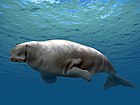Prorastomidae
| Prorastomidae Temporal range: Eocene
| |
|---|---|

| |
| Prorastomus sirenoides | |
| Scientific classification | |
| Domain: | Eukaryota |
| Kingdom: | Animalia |
| Phylum: | Chordata |
| Class: | Mammalia |
| Order: | Sirenia |
| Family: | †Prorastomidae |
| Genera | |
Prorastomidae is a family of extinct sirenians from Jamaica, related to the extant manatees and dugong.[1][2][3] The family includes the oldest known fossils of Sirenians, represented in two genera:

Pezosiren comprises one known species, Pezosiren portelli, that was discovered in modern-day Jamaica.[4] One of the earliest true Sirenian species, P. portelli is distinct from extant Sirenians due to its quadrupedal stature. The species is estimated to have lived 50 million years ago during the Mid Eocene, and the skeletal elements suggest that P. portelli was able to properly support its body weight while out of the water. However, several morphological features suggest that this species spent significant amounts of time in an aquatic environment, such as P. portelli's pachyosteosclerotic ribs.[5] Similar to an extant manatee's ribs, these ribs provided a ballast and allowed the animal to achieve neutral buoyancy. P. portelli lacked the large, muscular tail used in modern Sirenians to propel through the water column, and skeletal anatomy suggests that they instead garnered propulsive force through spinal undulations, similar to otters. This evidence suggests that P. portelli likely divided its time between terrestrial habitats and shallow aquatic habitats, convergently akin to hippopotamuses.[6]
The genus Prorastomus is also represented by only one known species. Prorastomus sirenoides lived in modern day Jamaica during the Mid Eocene, and it is thought to be the oldest Sirenian species discovered so far.[7] Similar to P. portelli, this quadrupedal Sirenian likely displayed a lifestyle comparable to hippos, spending large amounts of time both in and out of water. The species was determined to have had relatively large olfactory bulbs for a Sirenian, suggesting that the sense of smell was of importance to P. sirenoides, and the trigenimal nerves, utilized in somatosensory, were found to be enlarged.[8] Extant Sirenian species possess comparably large trigenimal nerves, allowing for highly sensitive facial tactility.[9] Dentile fossils of P. sirenoides suggest that the species fed primarily on floating and emergent vegetation along its habitat.[10]
See also
References
- ^ "Fossilworks: Prorastomidae". fossilworks.org. Retrieved 17 December 2021.
- ^ Marsh, Helene; O'Shea, Thomas J.; Reynolds, John Elliott; III, John E. Reynolds (December 2011). Ecology and Conservation of the Sirenia: Dugongs and Manatees. Cambridge University Press. ISBN 9780521888288.
- ^ "Family †Prorastomidae - Hierarchy - The Taxonomicon". taxonomicon.taxonomy.nl. Retrieved 2019-06-27.
- ^ Domning, D. P. (2001). "The earliest known fully quadrupedal Sirenian" (PDF). Nature. 413 (6856): 625–627. Bibcode:2001Natur.413..625D. doi:10.1038/35098072. PMID 11675784. S2CID 22005691. Retrieved 22 July 2020.
- ^ Prothero, D. R. (2009). "Evolutionary transitions in the fossil record of terrestrially hoofed animals". Evolution: Education and Outreach. 2: 239-302. doi:10.1007/s12052-009-0136-1. S2CID 32344744. Retrieved 22 July 2020.
- ^ Domning, D. P. (2001). "The earliest known fully quadrupedal Sirenian" (PDF). Nature. 413 (6856): 625–627. Bibcode:2001Natur.413..625D. doi:10.1038/35098072. PMID 11675784. S2CID 22005691. Retrieved 22 July 2020.
- ^ Díaz-Berenguer, E.; Badiola, A.; Moreno-Azanza, M.; Canudo, J. I. (2018). "First adequately-known quadrupedal sirenian from Eurasia (Eocene, Bay of Biscay, Huesca, northeastern Spain)". Scientific Reports. 8 (1): 5127. Bibcode:2018NatSR...8.5127D. doi:10.1038/s41598-018-23355-w. PMC 5865116. PMID 29572454.
- ^ Benoit, J.; Crumpton, M.; Mérigeaud, S.; Tabuce, R. (2013). "A Memory Already like an Elephant's? The Advanced Brain Morphology of the Last Common Ancestor of Afrotheria (Mammalia)". Brain, Behavior and Evolution. 81 (3): 154–69. doi:10.1159/000348481. PMID 23548592. S2CID 6524017. Retrieved 22 July 2020.
- ^ Sarko, D. K.; Johnson, J. J; Switzer III, R.C.; Welker, W. I.; Reep, R. R. (2007). "Somatosensory nuclei of the manatee brainstem and thalamus". The Anatomical Record. 290 (9): 1138–65. doi:10.1002/ar.20573. PMID 17722080. S2CID 8328805. Retrieved 22 July 2020.
- ^ Savage, R. J. G.; Domning, D. P.; Thewissen, J. G. M. (1994). "Fossil sirenia of the west Atlantic and Caribbean region. V. The most primitive known sirenian, Prorastomus sirenoides Owen, 1855". Journal of Vertebrate Paleontology. 14 (3): 427-449. doi:10.1080/02724634.1994.10011569. Retrieved 22 July 2020.

